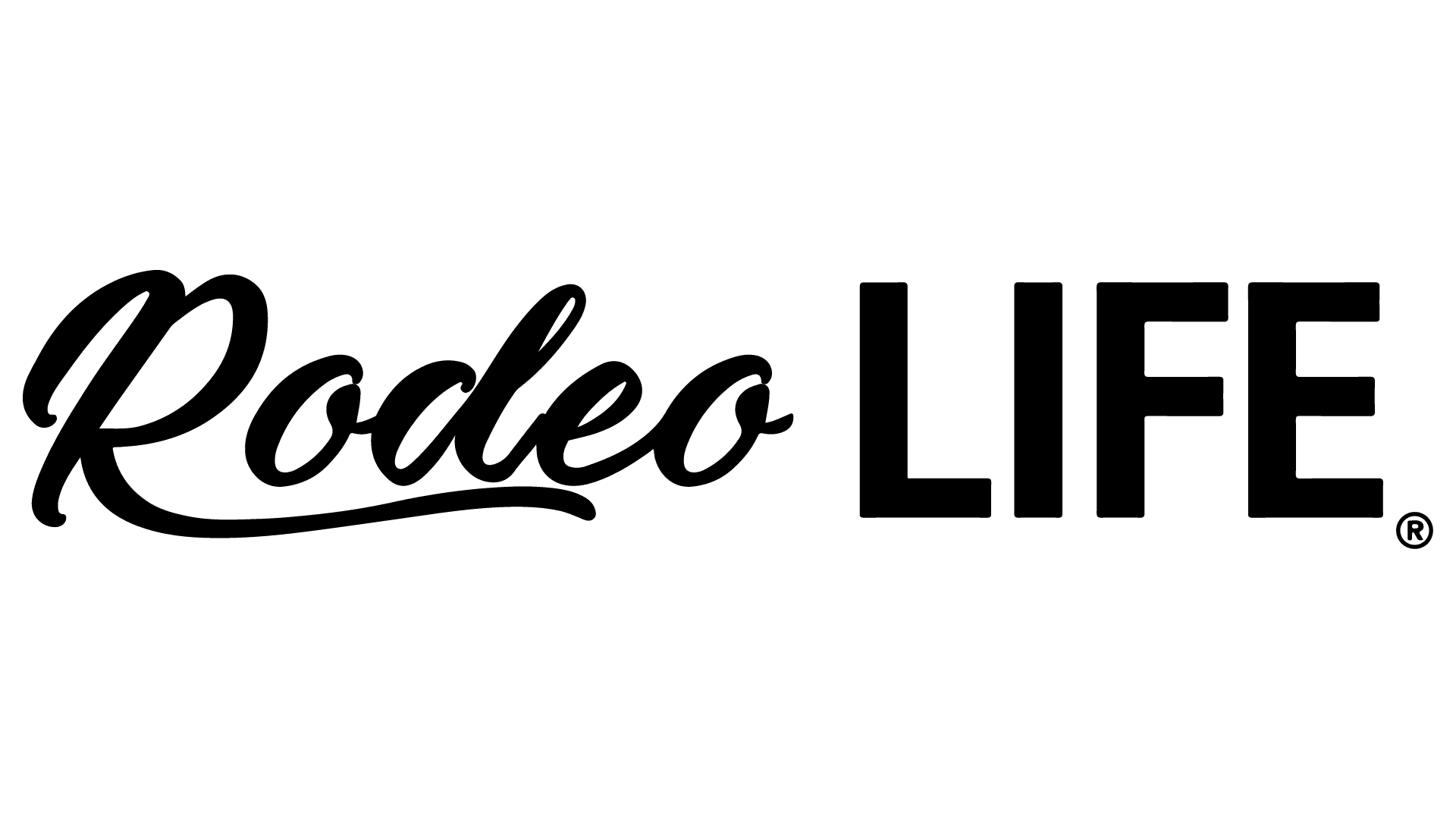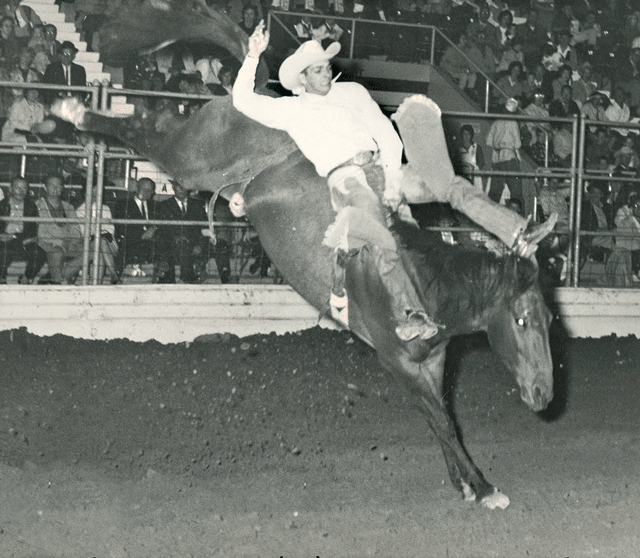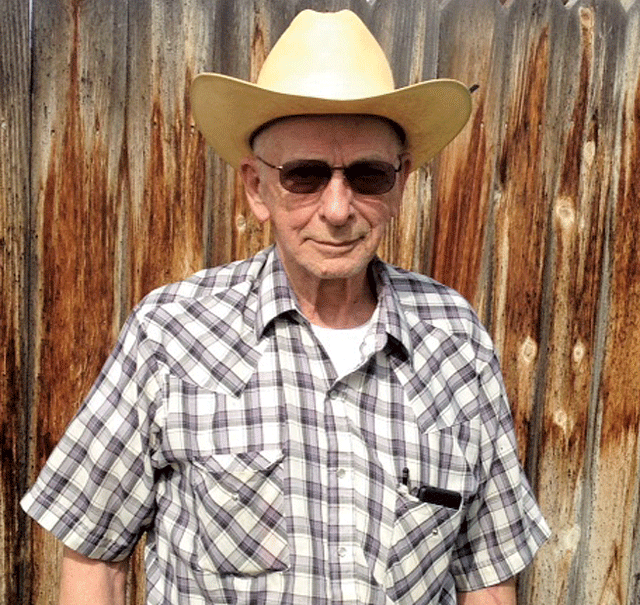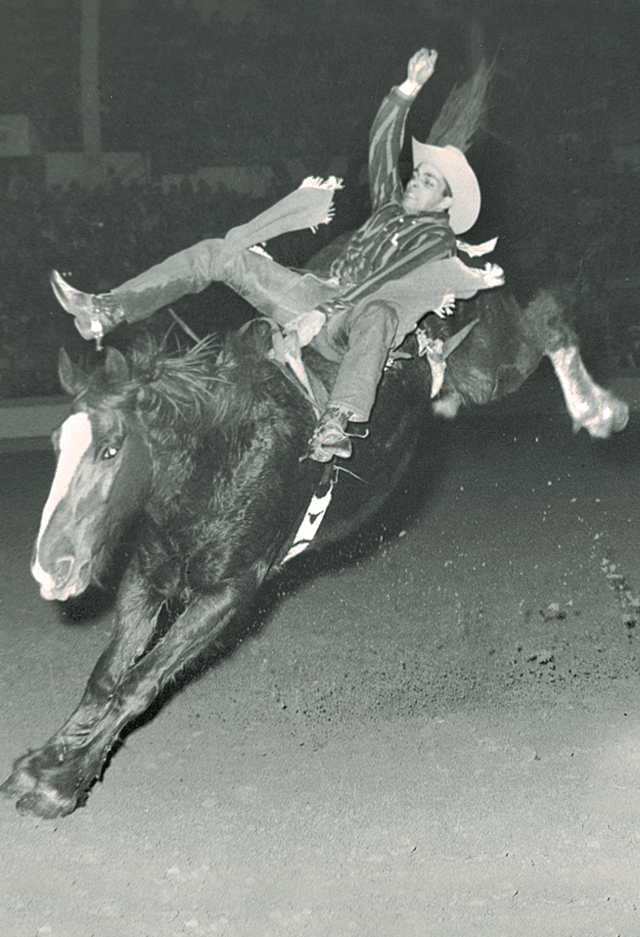It was while riding his dad’s milk cows that Ken Stanton got the inspiration to be a rodeo cowboy. The Weiser, Idaho man spent over two decades in pro rodeo, competing in both the bareback riding and the bull riding, and qualifying nine consecutive years for the National Finals Rodeo, six of those years in both of his events.
He was born in 1941, the youngest of four children of Roy W. and Lillian (Pattee) Stanton in The Dalles, Ore. The family moved to Cloverdale, Oregon, five miles from Sisters, and the kids attended Redmond High School. Ken was an outstanding wrestler, winning the state championship two years and finishing one year as runner-up. As a freshman, he wrestled at 98 lbs. and four years later, at 115 lbs.
Even though he had wrestling scholarships from Oregon and Oregon State, he chose to go to work, cowboying on a cattle ranch in eastern Oregon. It was winter time and one of the coldest winters, when he was on the wagon, throwing bales, while another worker was driving the tractor. One day, Ken told him, “it’s your turn to throw bales,” and the guy said no. Ken replied, “You are today, because I’m leaving.”
He took off for Odessa, Texas. He and his older brother Bill had competed in a half-dozen amateur rodeos (there was no high school rodeo then), and together, they headed south. He didn’t win money in Odessa, but a week later, in San Antonio, won $1800, more money than he’d ever seen before. He wasn’t greedy: “I sent most of it home to the folks because I didn’t need it.”
Ken stayed in the south, rodeoing at Rodeo Cowboys Association rodeos. He got his RCA card in 1960 and was a full time cowboy for the next decade. Bull riding was his favorite, but he was pretty even in his talent at both.
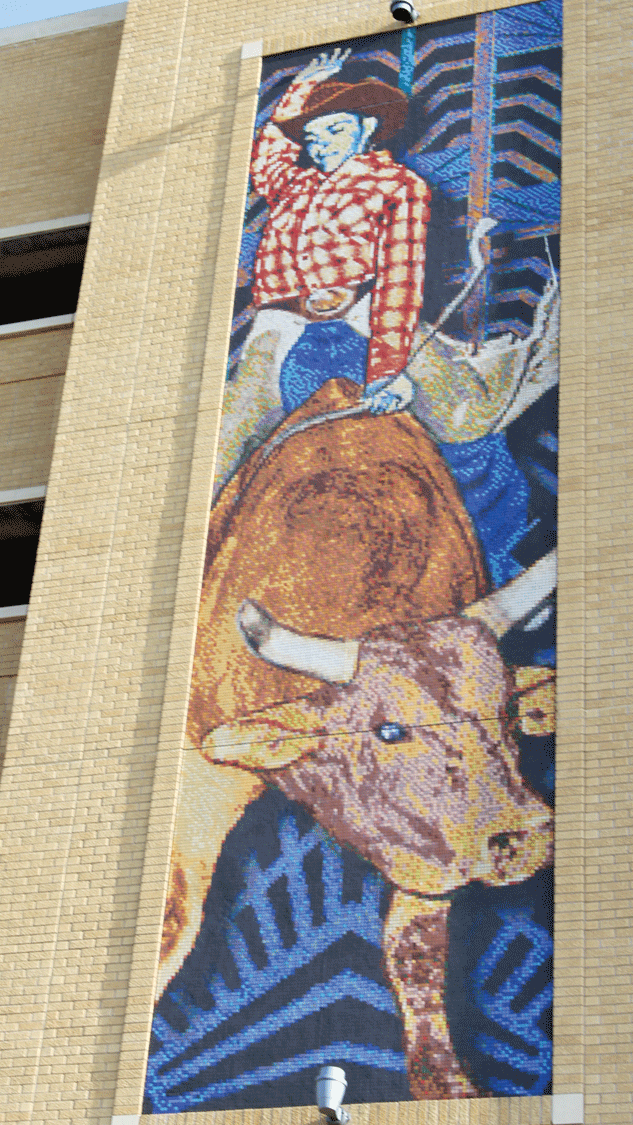
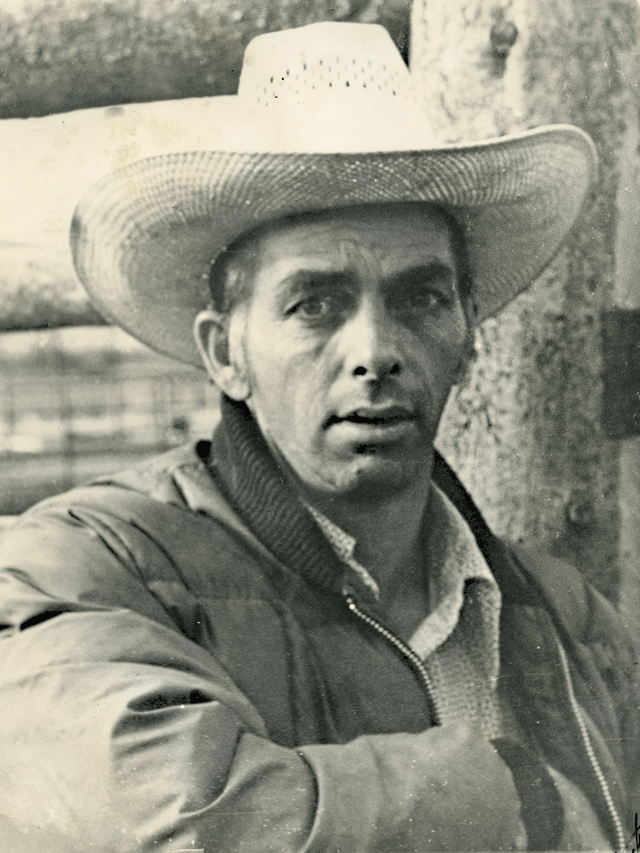
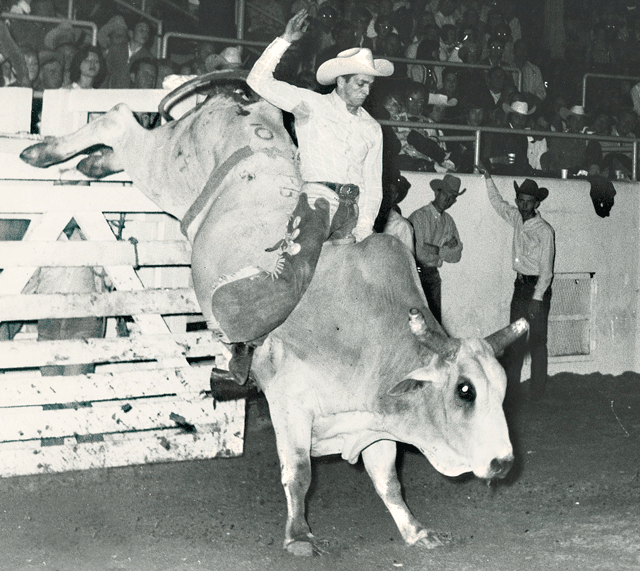
He was a natural at bareback and bull riding. He was small: only 5’4” and 145 lbs., but wiry and strong. In high school, he had jumped on the school’s trampoline, strengthening his core and improving his balance while entertaining fans during basketball halftimes. And he’d worked hard on his family’s ranch, throwing bales that weighed as much as he did.
From 1960 to1970, he rodeoed in the south during the winter and headed to the Northwest for the summer. He competed at about fifty rodeos a year, when other cowboys were going to 100 or more.
And he did well, financially. He estimates he averaged $22,000 a year as income over the ten year period, with his best year earning $28,500. “That was a good income for us,” he said. “It was a lot of money then.”
He competed at the National Finals Rodeo every year from 1962 through 1970, in the bareback riding eight times and the bull riding seven times. His highest finish was fourth place in the bull riding in 1964. In 1970, he was ahead of Gary Leffew in the bull riding, both having covered eight bulls, till Ken got bucked off his ninth bull and Gary beat him by only 35 points on nine head. “If I’d have rode (the ninth bull), nobody could have touched me.” He finished that year second in the average.
When he was on the road, his family went with him. He married Ginger Tarter in 1965 and they had three children: daughter Tracy and sons Scott and James. The kids loved being on the road. “They were like rodeo orphans,” Ken said. “The kids loved (being at rodeos) and people loved them.” Some of Ken’s fondest memories were at the Pendleton Round-Up. His parents and Ginger’s parents attended the Round-Up, and they’d take a big box of tomatoes grown by friends of his parents’. The cowboys loved it. “They couldn’t wait for us to get there, and they’d sit there and eat tomatoes,” Ken recalled. “It was like a family reunion.”
The year 1970 was his last year of full time competition. He spent the next three years working as a general contractor in Colorado Springs, building homes. Then he became a deputy sheriff for Washington County, Idaho, his home county. He worked that job for ten years, handling the civil lawsuit work and some of the jailer duties. He competed in a few rodeos, but not many.
After ten years of deputy sheriff duties, Ken went to work for a gold mine in Battle Mountain, Nevada, driving a 350 ton haul truck and working there till 2000.
It was an injury that started on the eastern Oregon ranch and culminated while he was a deputy sheriff that bothered him the rest of his life. On the ranch, he had gotten frostbitten feet while feeding cattle. A few years later, while traveling on slick roads on a cold snowy day with his wife and daughter, the car went into the ditch. Ken ran for help, running eleven miles in two and a half hours and getting frostbite again. The final straw was as deputy sheriff. He was working an accident that started with one car in the ditch on icy roads, and seven hours later, was a seventeen-car pileup. His feet were frozen, and gangrene set in. Doctors amputated two toes in 1974, then a few years later, his feet at mid-arch. In 2004, his left leg was amputated four inches above the knee. His leg’s veins had collapsed.
The toughest bull Ken saw while rodeoing was Snowman, owned by the Christensen Brothers. The bull had been unridden for five or six years when Ken drew him at Pendleton. He got bucked off at the whistle and remembers seeing Jim Shoulders and Harry Tompkins kneeling in the arena, watching the ride. He also remembers their comment: “that bull can’t be that bad, that kid almost rode him.” It was several more years before someone made a qualified ride on Snowman.
Ken was part of a unique brotherhood. At the 1967 and 1968 National Finals Rodeos, five contestants: Ken, his brother Bill, Jim Ivory, his brother John Ivory, and Larry Mahan were all graduates of Redmond High School and all members of the wrestling team.
After his leg was amputated, Ken moved back to Weiser, where he lives with his brother Bill, who also competed at the National Finals Rodeo. Ken and Ginger divorced in 1981. His daughter Tracy, who has five children, lives a few miles away. His sons, Scott and James, live in Boise. Ken has three great-grandchildren.
He served as bareback riding director for two years, but it wasn’t for him. And he was asked to judge rodeos, but by then, his feet were bothering him and it was difficult to stand for long periods of time.
His brother Bill, who was a year and a half older than him, had a plane and a pilot’s license and they would sometimes fly to rodeos. Ken remembers one time when they left St. Paul, Oregon, headed south of San Francisco. As soon as Bill got the plane off the ground, he asked Ken to take the wheel for a minute. “Then Bill jumped into the back and said, ‘wake me when we get to Bakersfield,’” Ken laughed. They were cruising at 12,000 feet, and Ken knew Mt. Shasta was 13,000 feet, so he pulled the plane up to 14,000, following the freeway to their destination.
His dad always knew when his boys had been riding the milk cows. “One of us would get on, and the other would turn her loose,” Ken remembered. “The hard part was ducking under the door.” The next day, those cows wouldn’t give milk, and it would be a dead give-away for the boys’ antics. His dad would ask, “have you boys been riding them cows?”
Ken is an inductee into the Ellensburg (Wash.) Rodeo and Pendleton Round-Up Halls of Fame. At Ellensburg, he won the bareback riding, bull riding, and the all-around several times. Lewiston, Idaho was also a rodeo he won multiple times.
Ken loved having his family with him as he rodeoed, and he loved rodeoing. “I wouldn’t trade it for nothing now,” he said. He never won a world title but he stayed in the top fifteen, competing at half as many rodeos as the others. “It’s in your blood or you just don’t do it,” he said. “It’s not easy but it’s a good way to make a living.”
